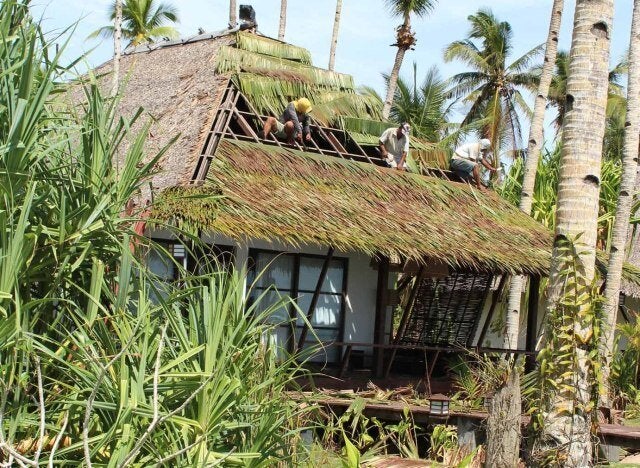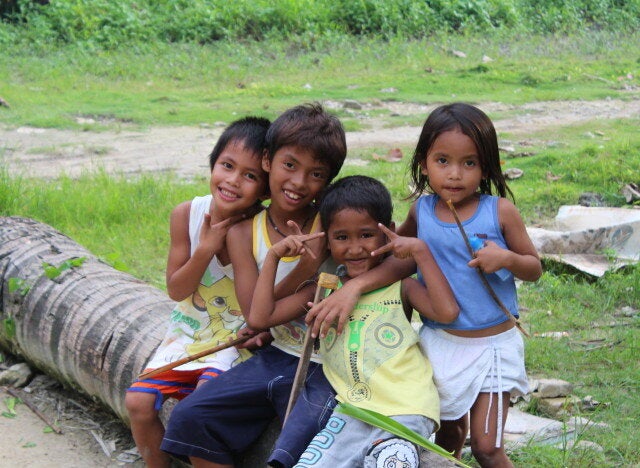After hours of sweaty, sleep-deprived, denim-clad travel, the first holiday beer is often the sweetest.
But when we drank our first San Miguel Light on Siargao Island to toast our small victory against the travel overlords, the sense of relief among our group was muted.
We'd just reached the Philippines for a two-week beach, spa and city break, just a week after Typhoon Haiyan devastated the centre of the country, 70 kilometres north of our first stop.
After the typhoon hit, we naturally assumed our trip was off. And sure enough, the message soon came through that our stylish Kalinaw resort had been closed.
Winds had come up during the overnight storm, blown the roofs off the villas, pushed sand far up the beach into the buildings and eroded the land. And all the exotic flower displays has been destroyed.
None of which seemed unlikely considering the terrifying footage on television.

Kalinaw Resort, Philippines. Credit: Sarah Warwick
But as we phoned round the other resorts, it became clear that our hotel had been the exception.
"It was just really windy," laid-back Sagana resort owner Gerry said to us on the phone, days after his idyllic home had sat slap bang in the path of the strongest storm ever recorded.
So while the rest of the world watched the rising death toll on the BBC, our three-strong group were now reconciling themselves to the fact that their holiday might still be intact.
The eye of the storm missed Siargao by a hair's breadth. So instead of destroying nipa huts, snapping coconut trees and causing power failures, just one resort lost a few roofs and needed a paint job.
"Yes, we have food. Yes, we have water. Yes, the planes are running. And yes, dears, we have Wifi."
Gerry kindly repeated his answers time and time again via phone and email, as we checked and rechecked we weren't sleep-walking into a catastrophe.
And that's how we ended up sitting in front of a moonlit view of the Pacific Ocean, enveloped by warm breezes and awkwardly sipping beers in the Philippines, one week after Typhoon Haiyan.
Miraculously our picture-postcard, 20-mile long island, dotted with paddy fields, colourful villages and giggling children, had escaped the tropical cyclone almost unharmed.

Children on Siargao Island. Credit: Sarah Warwick
During our stay, we learned the islanders had handled the typhoon very differently. Most of the Western resort owners headed up to the hills, armed with water, flashlights and a grim sense of reality, in order to avoid the waves.
Some tourists braved it out in their beach cabins, putting mattresses up against windows and buying chocolate; waiting out the seven-hour storm in mini forts as the winds picked up. They claimed to be afraid of the mudslide danger higher up, but this approach was generally accepted to be "idiotic" by those living on the island.
Many locals Filipinos, according to Western resort owners, stayed at home, unaware that if the winds had come much further inland then there would have been havoc.
In the run-up to the disaster, Filipino officials had described Typhoon Yolanda as a 'tidal surge' rather than a 'tsunami', making lil ole Yolanda sound more like a slightly vicious wave, and certainly nothing to have you packing up the dry goods shop, and heading for the hills.
For us, the only real sign of Typhoon Haiyan came on the way to Siargao during a stopover in Cebu, the airport where much of the aid is being loaded on to cargo planes. As we sat on the tarmac in our orange, low-cost Cebu Pacific party plane, we looked comically out of place among the military aircraft bringing aid from all over the world.
Yet, that's not to say we brought nothing. On a small island like Siargao, with a population of 200,000, it doesn't take much to upset the local economy. Many tourists cancelled and owners tried to hide their concern about empty rooms, bars and a lack of Christmas bookings.
The locals had already done their bit for the relief effort, with resort owners clubbing together and raising $15,000 dollars to buy a boat packed with building materials.
But as our resort owner said: "It's a typhoon. There hasn't been one for 30 years. It's probably about time for one. They do happen. But if that puts off the tourists coming to this island, that really would cause problems...."